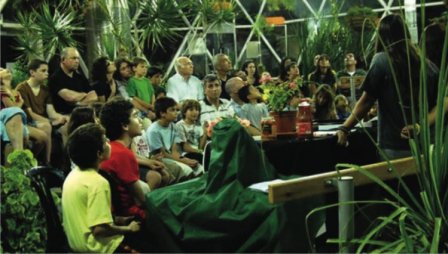
Five thousand people, including many families with children, visited the Weizmann Institute of Science campus recently to take part in "Researchers' Night." Researchers' Night has been an annual event in Europe for a number of years, and two years ago, in the framework of a partnership between the Israeli Ministry of Science and the European Union (EU), Israel adopted the idea. The event is held on the same date across Europe and in various places in Israel.
Children and adults alike enjoyed a fascinating evening of guided tours of the Institute's Clore Garden of Science, the Joseph H. and Belle R. Braun Center for Submicron Research, the laboratories of the Koffler Accelerator, and the Jean Goldwurm 3-D Visualization Theater.
At the Clore Garden of Science, visitors were treated to a demonstration, with audience participation, of "Vacuum Power," a recreation of the famous Magdeburg experiments. The first such experiment took place in the late 1600s at Magdeburg, Germany, at the instigation of Otto von Guericke, a scientist, politician, and inventor who helped prove the physics of vacuums. For centuries now, people have enjoyed taking up the challenge to fight the power of the vacuum, carrying out their own versions of the Madgeburg experiment—which involves trying to pull apart two hemispheres held together by vacuum power—such as at Researchers' Night.
Science Café
Scientists and research students from the Institute came out of their labs to meet the public. These meetings took place not just on campus, but also in coffee shops in nearby cities. In this setting, called "Science Café," the scientists and students talked informally with café patrons, giving the community a taste of the burning questions facing the researchers in their day-to-day work at the cutting edge of science.
The response to these casual encounters was overwhelmingly positive, and several coffee shops reported capacity crowds.
Draw Me a Scientist
"Israel is, without a doubt, part of the family of nations of Europe," said Gianmatteo Arena, Head of the Operations Section of the EU Delegation to the State of Israel (and acting Science Counselor of the Delegation).
Arena was visibly moved as he spoke at the opening ceremony of the exhibition of children's artwork, "Draw Me a Scientist," which took place during Researchers' Night at the Jeanne and Joseph Nissim Pavilion at the Clore Garden of Science. The opening was the culmination of an Israel-wide children's drawing competition undertaken by the Weizmann Institute in which children were invited to show in their drawings what they imagined a scientist to look like. From the many hundreds of drawings sent in to the contest, 32 were chosen to hang in the exhibition, and four were awarded prizes.
Institute Vice President for Resource Development Prof. Israel Bar-Joseph, who awarded certificates to the winners, said in his speech that "Science and art start off from the same point: from an idea, or from imagination. Only farther on do the two separate: Science deals with facts, in an attempt to understand the world in which we live. Art, on the other hand, offers us an interpretation of our world. When these children set out to draw a scientist from their imaginations, as they see us, we were asking them in effect to give us a mirror. This exhibit, over and above its aesthetic and artistic aspects, is really a kind of social experiment from which we can learn how children see us scientists. And for this valuable insight, we sincerely thank you."
Prof. Bar-Joseph then read to the children, parents, and invited guests the words that Noa Kahana, age 11, had attached to the picture she sent: "My picture is called ‘constant activity' and it shows a woman scientist who is excited to discover thousands of things at once. She is tired and exhausted, but encouraged by the fact that in a little while she will succeed in discovering what she wants."
Also taking part in the opening ceremony were Dr. Yoav Rozen, Director General of the Ministry of Science, Culture and Sport; and David Wizel, Project Officer of the Directorate-General for Research, Strategy and Policy Aspects of the European Commission, who came especially from Brussels to attend the opening.
The Weizmann Institute of Science in Rehovot, Israel, is one of the world's foremost centers of scientific research and graduate study. The American Committee for the Weizmann Institute of Science is a community of dedicated people who share a common vision in support of the Institute. The generous assistance the Weizmann Institute receives from individuals, foundations, and corporations is vital for its future. Committee members show their devotion to the advancement of the Institute's goals by becoming partners in the search for answers to the most difficult challenges facing humanity.
